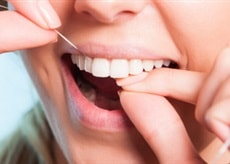 You’ve probably heard that the three pillars of a healthy smile are simple: brush, floss, and go to the dentist regularly for check-ups. While brushing and getting your routine cleaning appointments seem relatively simple for most patients, flossing is another challenge in itself.
You’ve probably heard that the three pillars of a healthy smile are simple: brush, floss, and go to the dentist regularly for check-ups. While brushing and getting your routine cleaning appointments seem relatively simple for most patients, flossing is another challenge in itself.
Flossing is often considered an unpleasant and time-consuming process for a large portion of patients. In fact, it’s safe to say a majority of patients feel uneasy when their dentist asks how frequently they floss.
A 2013 study from the American Dental Association reveals quite a bit about the flossing habits of adults in the US. Findings reveal, only approximately half the population floss daily while 31% floss less than daily and 18% of Americans do not floss at all.
Recent news reports have published claims that flossing doesn’t actually provide any benefits to dental health. So, how important is flossing for a healthy smile? Dr. Edward Gottesman and the talented staff at PerioNYC clear up this rumor and explain the importance of flossing for a healthy smile.
The Real Facts: Floss For A Healthy Smile
Earlier this year, the Associated Press published a story questioning the effectiveness of flossing for oral health. The AP asked the Department of Health and Human Services and the Department of Agriculture for evidence proving that flossing was essential for proper dental care. The following year, when the federal government failed to respond to the request, the recommendation to floss was removed from their guidelines.
The American Dental Association responded by stating that lack of scientific evidence does not imply flossing is ineffective. Bottom line: Flossing is an absolutely critical aspect to maintaining good oral health.
The ADA also believed that the federal government had not changed its stance on the importance of flossing and instead, made a conscious decision to focus on nutrient intake and excess sugar consumption.
Regardless of your methods, interdental cleaning is an important aspect of proper dental hygiene.
Flossing is a key part of dental health because bacteria can easily get trapped in areas that are hard-to-reach with a toothbrush. With more than 500 bacterial species found in plaque, it’s no surprise that flossing makes a huge difference for the health of our teeth and gums.
Not flossing frequently enough or flossing poorly can result in a range of dental problems, including:
Tooth Decay: When bacteria accumulates in hard-to-reach areas, they will continue to feed upon sugar and produce an enamel-eroding acid. Given enough time, your enamel can wear down and put the sensitive inner layers of the teeth at risk for infection.
Gum Disease: As with the case of tooth decay, acids produced from bacteria in between your teeth will also irritate and inflame the gums. Patients with this particular problem will notice that their gums appear swollen and red. It’s also common for gum disease to cause the gums to bleed when brushing or flossing.
If this problem persists without treatment, the infected gums continue to worsen and the connective tissue and underlying bone will be destroyed. Patients with severe gum disease may also experience tooth loss.
Chronic Bad Breath: It’s easy for food particles to get trapped between teeth when you do not floss frequently enough. When the food particles remain in between teeth, bacteria not only have something to feed upon but the food will also begin to rot and give off a foul odor.
Proper Technique For Flossing
With all things considered, flossing should not be an underestimated tool when it comes to keeping your smile healthy. On average, it should take around two minutes to properly clean between each tooth. Add in the 2-3 minutes of brushing your teeth and your total oral hygiene routine is only around five minutes.
Spending five minutes to properly clean your teeth will keep your smile looking beautiful and saves you the trouble and pain of extensive dental treatment. Efficiently removing plaque from between your teeth is simply, and goes as follows:
- Use about 18 inches of floss and wrap each end of the floss around your index finger to hold taut
- Gently slide between each tooth and follow a “C” motion to get underneath the gumline
- Use a clean piece of floss as you make your way around
- Make sure to floss on the backside of the tooth and dispose of the used floss when finished.
Contact Our Office in Manhattan
Despite reports from the media, flossing is still a crucial part of proper oral hygiene. Many problems associated with poor dental health can be easily addressed by paying special attention to your oral hygiene routine.
In the event of more serious oral health concerns, we recommend getting the help of a dental professional. Here at PerioNYC, we offer a range of services to best help address your specific concerns. To get started today, contact our office and find out how we can help your smile!


